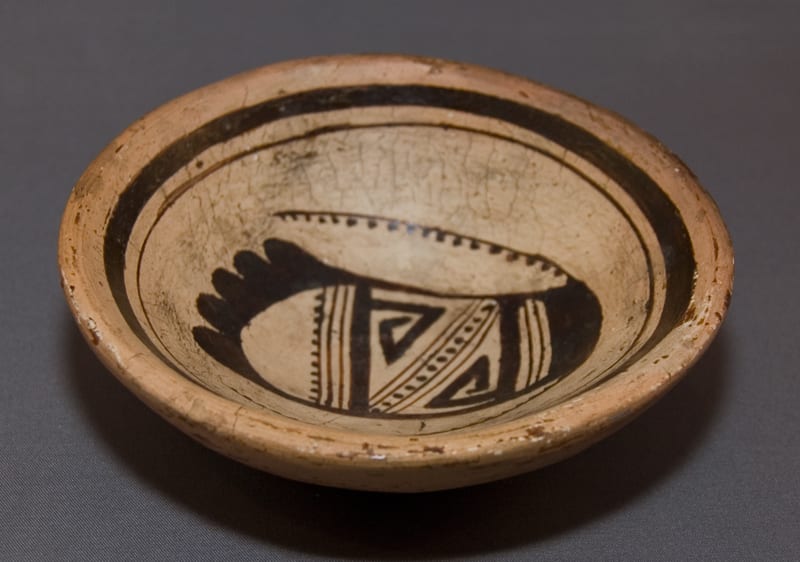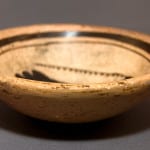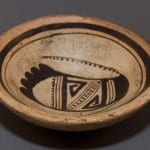This small, unsigned pot has a classic Polacca crackled slip on the interior and is decorated with a monochromatic image of a foot with design elements that perhaps represent migration paths. (Note: A Pahana’s interpretation of the “meaning” of a design is dubious, at best. See LeBlanc’s comment in the discussion of 1997-05.)
The foot motif, thick-over-thin framing lines and use of blank space to set off the design are not found on Polacca ware. Moreover, the bowl lacks the red rim characteristic of the earlier Polacca ware and also unlike Polacca ware, the exterior is unslipped and stone-polished. While the bowl is casually made, the drawing is precise and exceptional and makes a major visual impact.
Thus there is a disjunction between the interior Polacca slip and the other decorative elements of the bowl. Uncertain about how to characterize the bowl, I took it with me when my nephew David Alexander and I visited Ed Wade and his wife Carol in Sedona, November 19-20, 2009. Ed quickly concluded that the bowl was made by Nampeyo and dated it as made about 1890.
Wade believes that the foot design on bowl 2009-08 was not inspired by Sikyatki pots, but is an adaptation of the petroglyph drawing found on cliffs around First Mesa. Hand and foot designs were commonly used in these rock drawings to mark the passage of clans migrating and lines with dots were often carved into the rock to indicate the passage of time. The small size of the bowl suggests it was made for sale to Keam since it could be packed easily into tourist luggage, he added.

Petroglyph of feet at Hopi

A petroglyph owned by the Houston Museum of Natural Science
Ed Wade has an expert understanding of Hopi pottery (cf 2012, 2022), but can we find independent evidence that this small bowl is “by Nampeyo”? I believe we can. In my discussion of jar 2005-16 in Appendix B, I defined six distinctive characteristics of Nampeyo’s Sikyatki revival pottery made from about 1900 until she became functionally blind about 1920:
1) A tension between linear and curvilinear elements, often represented as a contrast between heavy and delicate elements;
2) A deliberate asymmetry of design;
3) The use of color to integrate design elements;
4) The use of empty (negative) space to frame the painted image; and
5) The use of a thick above a thin framing line on the interior rim of her bowls.
6) Nampeyo’s painting is confident, bold, and somewhat impulsive compared to the more-studied, plotted and careful style of her daughters, descendants and other Hopi and Hopi-Tewa potters.
Five of these six decorative techniques are present on bowl 2009-08. The obvious exception is technique #3 since the bowl is monochromatic.
1) The overall pattern on the lines and dots within the foot design form a large linear Z which causes an observant eye to sweep across the image as the eye moves downward. Contradicting this are the two counterclockwise hooked images, themselves contradictory since one is open at the top and one at the bottom. The heavy toes seem to move the foot forward. The curved dotted lines that flank the foot are visually light, contradict the heavy linear lines within the foot . The flanking dotted lines draw the eye in the direction of movement.
2) The design is inherently asymmetric since a foot is not symmetric. The design interior to the foot is not symmetric.
4) Negative space frames the image external to the flanking double lines and also between these lines and the foot.
5) The bowl has thick-above-thin framing lines characteristic of Nampeyo’s later Sikyatki Revival pots.
6) The painting is confident and bold. Lines are controlled but not exact. One crook is set a bit further from the edge of the foot than the other.
In short, this little bowl captures much of the genius of technique that would mark much of Nampeyo’s Sikyatki Revival production. It was this genius of design that attracted me to purchase the bowl without any sense that it might have been made by Nampeyo.
Bowl 2009-08 has the traditional Polacca crackled slip on the interior, but everything else (the exterior finish, lack of red rim and and design) contradicts the Polacca tradition. Contrast this style with Nampeyo’s piki bowl (2009-17) which has a traditional Polacca ware design, but with an unslipped and stone-polished finish that also contradicts the Polacca tradition. Following Colton (1956, type 18), both pots might best be typed as “Walpi Polychrome,” although likely made down the street in Hano. Now consider a third bowl in the collection: 1994-16, by an unknown potter. The crackled white slip and red lip on this latter jar are traditional Polacca style, but the idiosyncratic “doodled” design is not characteristic of Polacca ware and the wide-shouldered shape reflects the older Sikyatki tradition. All three pots were made about 1890 and all three capture a brief period (probably 5 to 8 years) in the 1890s when First Mesa pottery was undergoing rapid change from Polacca ware to what would become known as “Sikyatki Revival” style (though the new style drew on more sources of inspiration than Sikyatki). Sequencing the styles of the bowls from the older to newer style, I would probably order them 1994-16 then 2009-17 and then 2009-08, with the first of the three bowl retaining more traditional Polacca elements and the last bowl retaining the fewest.
During the early 1890’s there was great innovation among First Mesa potters as women experimented with new techniques and designs in order to find a style that would appeal to Anglo buyers. Three bowls in this collection (1994-16, 2009-17, and 2009-08) are quite different in shape, finish and design, but all three represent the spirit of experimentation and innovation that characterizes First Mesa potters (including Nampeyo) during this short period. Since bowls 2009-08 and 2009-17 were both made by Nampeyo, they also mark an important moment in the development of Nampeyo’s personal style.
See Appendix A for a more extensive discussion of these few years when First Mesa pottery styles underwent experimentation and rapid change.





